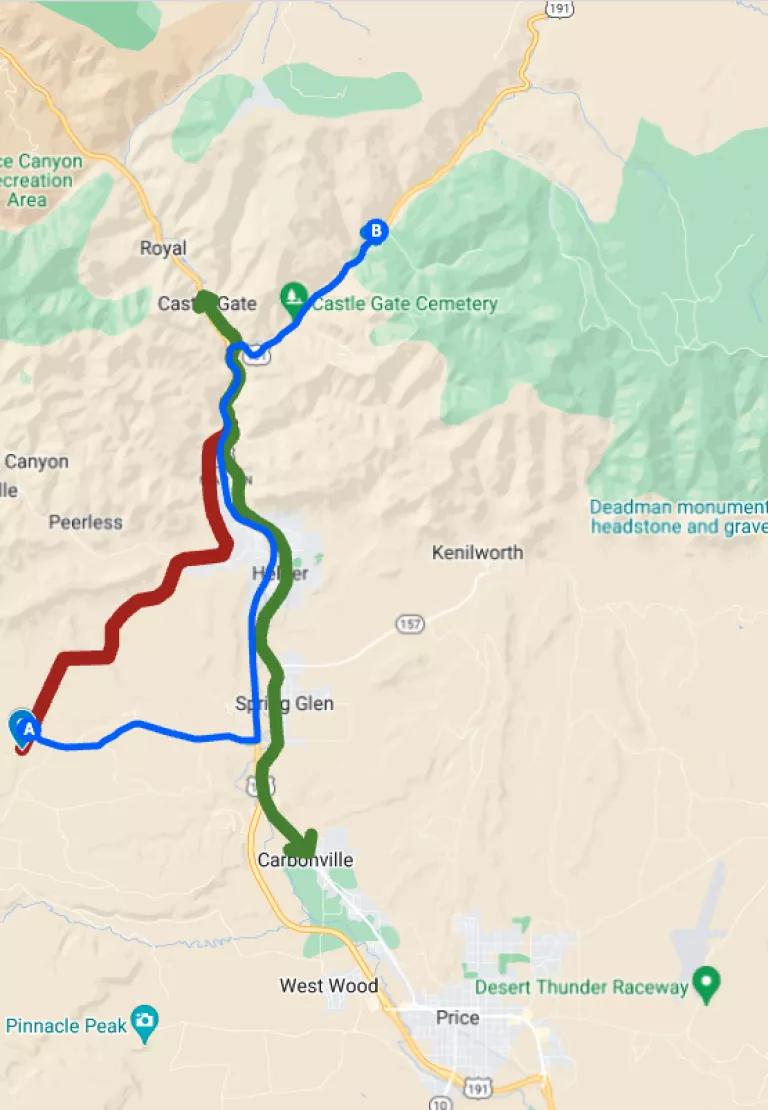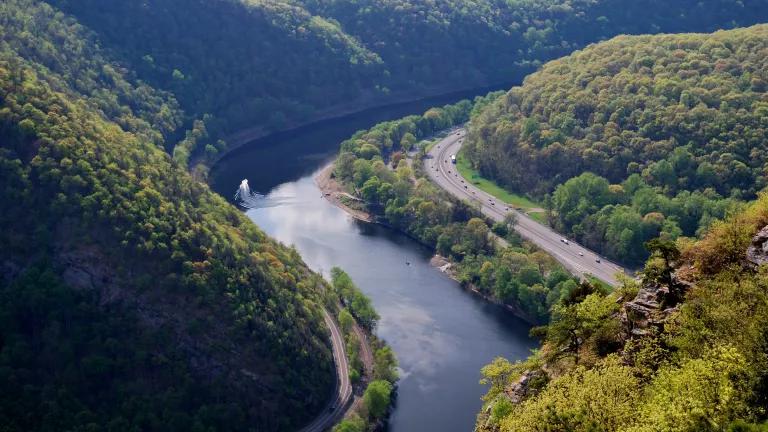Utah's Wildcat Loadout Project: A New Colorado River Threat
The Wildcat Loadout expansion could load 100,000 barrels of oil per day onto trains traveling beside the Colorado River and destined for Gulf Coast refineries.

Union Pacific's rail lines (left) hug the Glenwood Canyon walls beside the muddy Colorado River.
Credit: djvass via Flickr, CC BY-NC-ND 4.0
Utah’s Uinta Basin Sees Oil Production Renaissance
From the 1980s to the early 2000s, oil production in Utah’s remote Uinta basin was in gradual decline. But with the advent of new horizontal drilling technologies, the trend steeply reversed, with oil production rising from a low of 19,000 bpd in 2002 to a high of 87,000 bpd in 2021. Despite that steep, two-decade increase, production volumes have remained mostly flat near 85,000 bpd since 2014. And for good reason: the region produces yellow and black waxy crude oil, a unique substance that cannot move easily by pipeline and requires specialized refineries for processing. Those dueling constraints mean that the nearby refining market in Salt Lake City has historically been the oil’s primary destination, and its waxy crude processing capacity has not grown beyond 85,000 bpd.
Even amid an era bearing witness to out-of-control climate change—including projections of the near-term disappearance of Great Salt Lake in Utah—oil producers in the Uinta Basin are working overtime to significantly expand production. We covered one proposal—the Uinta Basin Railway project—in an earlier post. If built, that rail line would allow producers to expand production by 130,000-350,000 bpd. Fast on its heals, a new proposal has emerged—known as the Wildcat Loadout expansion project—that would allow an additional 70,000 bpd of Uinta Basin crude oil to access rail lines, while also dangerously increasing tanker truck traffic on local roads between the Basin and the rail loading facility.
Although new infrastructure remains unbuilt and increasingly controversial, the industry has forged ahead with finding ways to move its product to the one major market capable of handling waxy crudes: the Gulf Coast. Since 2021, production has again begun moving upward, with 2022 production rising extraordinarily to a high of 109,000 bpd. Recent reports suggest this number has grown even further to 135,000 bpd. Despite the high costs of relying on trucks and trains to reach the Gulf Coast, the relatively high cost of oil appears to be allowing Uinta Basin producers to profitably reach distant markets.
The Wildcat Loadout Expansion: Industry’s Latest Risky Proposal
The Wildcat Loadout expansion is a proposal by Coal Energy Group 2 LLC to expand the capacity of its waxy crude oil truck to rail transloading facility from 30,000 barrels per day to 100,000 barrels per day. By increasing transloading capacity, the project could spur new output from the Uinta Basin by up to 1 billion gallons per year. If built, increased access to existing rail lines would facilitate oil transport through Colorado and down to refineries along the Gulf Coast in Texas.

The Wildcat Loadout facility is located at Point A, which is connected by a rail line (red) to Union Pacific's rail lines (green). The facility receives oil by tanker trucks via State Highway 191 and a local highway (blue line).
Basemap courtesy of Google Maps.
So far, the Bureau of Land Management (BLM) has indicated that it may move forward with a cursory environmental assessment rather than an in-depth environmental impact statement. This was the approach they took in 2014 when they approved the last operating change to the Wildcat Loadout facility. But that approach is woefully inadequate. Already, the 30,000 bpd shipped to the facility require more than 100 tanker trucks traveling south along Highway 191 through the mountains to their transloading destination every day. With the expansion, that number would rise to nearly 360 tanker trucks per day, or a tanker truck every four minutes.
In August, environmental groups including NRDC delivered a letter to the BLM’s field office in Price, Utah, urging BLM staff to conduct a full Environmental Impact Statement (EIS) given the significant risks this project would create for the Colorado River and significant harms it would inflict on the global climate. Last month, Representative Neguse (CO-2) and Senator Bennett of Colorado wrote a letter to the Director of the BLM, Tracy Stone-Manning, also pressing the agency to prepare an EIS. The letter states that “[t]hese trains are proposed to run for over 100 miles alongside the Colorado River’s headwaters—a vital water supply for nearly 40 million Americans, 30 Tribal nations, and millions of acres of agricultural land.” This proposed facility expansion is a recipe for disaster, and it needs a full and thorough review of its environmental impacts.
Precious Western Waterways and the Global Climate Can’t Tolerate New Oil Infrastructure
The potential impacts for bodies of water cannot be overstated. Over 40 million people across seven states, tribal lands and parts of Mexico rely on the Colorado River for drinking water and irrigation. Though smaller in scope than the related Uinta Basin Railway project, the Wildcat Loadout expansion would allow for one fully loaded unit train of waxy crude oil to travel beside the river’s edge every day. That’s enough to drastically increase the risk of derailment—a fact that demands close study especially since the Uinta Basin Railway project’s EIS predicted a derailment every single year due to increased rail traffic on existing lines. This introduces risk to the water supply of millions of people for the transport of low quality waxy crude oil which would otherwise not have access to a market outside of Utah. The Colorado River also supplies the water necessary to keep the dams at Lake Mead and Lake Powell running, which supply electricity throughout the region.
Though the BLM has yet to consider the project’s cumulative greenhouse gas emissions, the analysis of the Uinta Basin Railway project is instructive. There, the Surface Transportation Board estimated that the annual greenhouse gas emissions caused by the project would range from nearly 20-53 million tons, depending on a low versus high development scenario. The low development scenario is equivalent to about twice as much new oil production as the Wildcat Loadout expansion would facilitate, though Wildcat would also require a large increase in emissions-intensive trucking to work. Thus, it’s a safe bet that this proposal comes with a 10-million-ton annual greenhouse gas price tag: a price the global climate cannot afford as we barrel headlong toward the 1.5° Celsius warming threshold and the significant and catastrophic consequences breaching the threshold will bring.
In an era of extended drought across much of the West and greenhouse gas concentrations in our atmosphere leading us to dangerous ecological tipping points, new and expanded fossil fuel infrastructure must not be built. The Wildcat Loadout expansion represents a risky financial bet on high oil prices that locks the Uinta Basin further into its dependence on oil. State and county leaders in the region need a new vision—one that diversifies the local economy, cleans up the mess that a century of oil production has left behind, and charts a course for these communities in a world moving away from oil dependence and addiction. The fragile Colorado River can’t tolerate the risks created by these projects. Neither can the climate.





